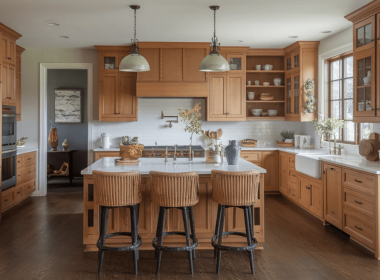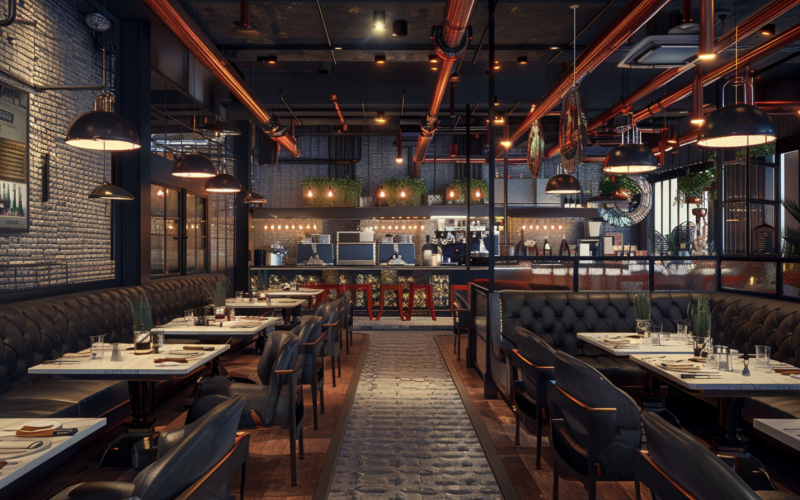Open ceilings, also known as exposed ceilings, are gaining popularity in modern interior design.
Many people are drawn to the industrial look and spacious feel they provide.
But what exactly is an open ceiling called? You’re not alone if you’ve wondered about this trendy design element.
This clarifies any terminology confusion and shares exciting, open-ceiling ideas.
In this post, I’ll explain the names used for exposed ceilings, discuss their key features, and highlight why they’re becoming a top choice for homes and offices.
By the end, you’ll have a solid grasp of open ceiling concepts and be inspired to consider this style for your space.
What is an Open Ceiling Called?
An open ceiling goes by several names, but the main terms you’ll hear are:
Open Ceiling: This is the primary term for this design style. It’s straightforward and tells you exactly what you’re getting – an open, uncovered ceiling.
Exposed Ceiling: This is another common name that paints a clear picture. It refers to the fact that all the structural elements above are exposed to view.
Open Plenum: A more technical term often used in commercial settings. The plenum is the space above a dropped ceiling for air circulation and utilities. When it’s open, you get an open plenum.
Characteristics of Open Ceilings

1. Visible structural elements
You’ll first notice that everything’s out in the open.
You can see the ductwork snaking across the space, trusses supporting the roof, and pipes running overhead.
It’s like peeking behind the scenes of a building.
2. No hiding panels
Unlike traditional ceilings, no tiles or panels cover the surface.
What you see is what you get; this raw, unfinished look is a big part of the appeal.
3. Industrial chic
Open ceilings fit right in with industrial and modern design styles.
They give off a cool, urban loft vibe that many people love.
This style is not trying to be pretty in a traditional sense—its beauty comes from its honesty.
4. Height boost
Without a drop ceiling, rooms often feel taller and more spacious.
This can make even smaller spaces feel bigger and airier.
5. Unique Personality
Each open ceiling is different, showing off the building’s unique structure.
This adds character and interest to a space you can’t get with a plain white ceiling.
Advantages of Open Ceilings
Aesthetic Appeal
Open ceilings bring a fresh, modern look to any space. They have this cool industrial vibe that’s popular right now.
What’s neat is how they turn things like pipes and ducts into design features. Your ceiling becomes a unique piece of art.
People love how it shows off the building’s inner workings, giving the space more character and interest.
Increased Space
One of the best things about open ceilings is how they make a room feel bigger.
Without that lower ceiling, everything feels more open and airy. It’s like the room can breathe.
This extra height isn’t just for show – it can also be useful.
Some folks find clever ways to use that vertical space, maybe for storage or to create a loft-like feel. It’s a great trick for making the most of your square footage.
Improved Lighting
Lighting gets a big boost with open ceilings.
Natural light has more room to spread, making the whole space feel brighter and more welcoming.
When adding your lights, you’ve got so many more options.
You can hang lights at different heights, create interesting patterns, or use the exposed beams and pipes to your advantage.
It’s a chance to get creative with your lighting design.
Disadvantages of Open Ceilings
Acoustic Challenges
Open ceilings can be a bit noisy.
Without those sound-absorbing tiles, noise tends to bounce around more. This can lead to echoes and a general increase in sound levels.
It’s not ideal if you’re after a quiet, peaceful space. But don’t worry, there are ways to fix this. People often use acoustic panels, baffles, or ceiling clouds to help control the sound.
These can look pretty cool, too, adding another design element to your space.
Maintenance and Cleaning
Keeping an open ceiling clean can be a bit of a hassle.
All those exposed pipes and ducts are like magnets for dust and dirt. You might find yourself cleaning more often than with a regular ceiling.
And let’s face it, cleaning up there isn’t always easy. It’s something to consider if you’re not keen on extra maintenance work.
Energy Efficiency
Open ceilings can sometimes increase your heating and cooling bills.
With more space to heat or cool, your HVAC system has to work harder. This is especially true in buildings not designed with open ceilings in mind.
To control energy costs, you might need to upgrade to a more efficient HVAC system. This is not a deal-breaker but should be factored into your decision.
Applications of Open Ceilings
1. Residential Spaces
Open ceilings are making their way into more and more homes these days.
They’re a big hit in lofts and modern houses where people want that spacious, airy feel.
An open ceiling can make even a small room feel much bigger in a home. It’s great for folks who like that industrial or urban look. But it’s not just about looks – it can also change how you live in the space.
You might find room for a reading nook up high or a cool suspended light fixture.
Some people add warm lighting or use rugs and furniture to make the space more comfortable.
2. Commercial Spaces
In the business world, open ceilings are all the rage. You’ll see them in trendy offices, hip retail stores, and cool restaurants.
They’re popular because they create a modern, creative vibe many businesses want.
An open ceiling in an office can make the workspace feel less stuffy and more inspiring. It might even boost productivity by making people feel less boxed in.
For stores and restaurants, it’s all about the atmosphere. An open ceiling can make a space feel more authentic and interesting, drawing customers in.
Plus, it gives businesses more flexibility with things like lighting and ventilation.
Remember that noise levels and energy efficiency must be considered on a larger scale in a commercial space.
Conclusion
Open ceilings offer a unique blend of style and functionality that’s hard to ignore. They can transform a space, making it feel larger, more modern, and full of character.
But they’re not without challenges. Noise, maintenance, and energy costs are real factors to consider.
So, is an open ceiling right for you? It depends on your specific needs and preferences.
It could create a stunning loft-like atmosphere in a home or a business, fostering creativity and attracting customers.
Before you decide, consider your space, budget, and willingness to handle the upkeep. And remember, there are ways to address the downsides, from acoustic treatments to efficient HVAC systems.
An open ceiling can be a fantastic design choice if it aligns with your goals and lifestyle.











